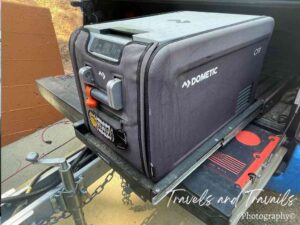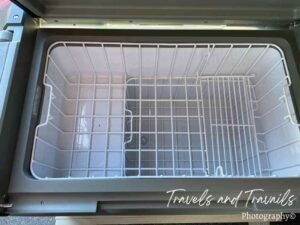If you live in your RV even part of the year, you know what a pain it is to figure out the ice situation. You either go without, which isn’t so fun, or you have to lug ice around, which is even less fun. Enter the electric cooler, which seems like it can be a salvation for RVers. Is it worth it?
Electric coolers can be very worthwhile. They don’t drop below 20 degrees Fahrenheit and can rise to around 60 degrees (for some models). Many use 12-volt power, as they’re designed for cars, but some can be costly.
In this guide, I’ll examine how these coolers work, the pros and cons, and other practicalities so you can decide how or if an electric cooler slots into your motorhome lifestyle!
What Is an Electric Cooler? How Does It Work?

Electric coolers are an awesome technology. While most fridges rely on compressors, an electric cooler doesn’t.
It uses electricity, as its name implies. You plug the cooler into a power source, such as directly into your motorhome, a portable battery, or a generator, and it will begin producing cold air.
How cold is cold here? That varies by model. As I mentioned in the intro, some electric coolers can provide cooling to 20 degrees. That’s plenty cold enough to maintain all your perishables.
Others operate on the warmer side, closer to 60 degrees. You’ll have to keep the door closed tight to prevent premature food spoilage, but it still suffices.
What Are the Pros of Electric Coolers?
Now that you better grasp the basics of electric coolers, let’s take a deep dive into the technology by reviewing the pros and cons.
Coolant-Free
Topping off the coolant levels in your compression RV fridge is just one of those parts of motorhome maintenance, or is it?
By switching to an electric cooler, you can forego the coolant. I don’t know about you, but that sounds great to me.
Can Double Your Cold Food Storage Space

Motorhome refrigerators are not nearly as big as the residential appliances in your kitchen back home. The average RV fridge has a storage capacity of six cubic feet. They come smaller at four cubic feet and can be larger at eight cubic feet.
By comparison, a household refrigerator is between 18 and 21 cubic feet. Even if your motorhome fridge is on the bigger side at eight cubic feet, you’re losing at least 10 cubic feet of food storage.
Maybe that’s not such a big deal if you only spend weekends or a few months of the year in your motorhome. However, it matters to those who live in their RVs full-time.
An electric cooler isn’t tremendously large, but it does offer a few more cubic feet to put your food. You can stock up on more at the grocery store without worrying about it going bad.
No More Ice!

Here’s the thing about ice chest coolers, an electric cooler alternative. They use ice, just as the name implies.
Ice is a pain to procure, just as I talked about in the intro. It’s so laborious to carry, and the question becomes, how much do you need for your ice chest cooler?
If you buy too much, you’ll have all this ice and nowhere to put it, as it’s not exactly like you have a big freezer (or maybe any freezer) handy in your RV. However, buy too little, and you might not adequately cool your food, which could spoil.
Once you switch to an electric cooler, you can finally put your ice woes (and the ice box cooler) behind you.
Takes Up Less Space
An RV is only so big, even if we’re talking about Class As. You must be careful about how you allocate the space, not only from a comfort perspective but also from a weight distribution perspective.
Adding an electric cooler to your motorhome is one of the most space-effective decisions you can make. They’re also moderately lightweight, weighing only a pound!
Designed for Vehicles
Electric coolers aren’t like the ice-chest coolers of yore. They’re made for vehicles, plugging into 12-volt power. That makes electric coolers an overall more accommodating choice.
What Are the Downsides of Electric Coolers?
As great as electric coolers are, they’re not perfect. Let’s review what’s not so great about ‘em.
Can’t Tightly Pack Them
You’re aware that an electric cooler only adds so much extra food storage space, so you’ll want to maximize that space to its fullest potential.
However, you can’t.
If you stack all your foods and beverages like you’re playing the world’s best game of Tetris, the air can’t flow through all the items in the cooler. This results in unevenly cooled items that can thaw and spoil.
Must Have a Source of Electricity
Ice and coolant might be finite resources, but so is electricity. Well, let me put that another way. Your access to electricity is finite in an RV.
You can’t stay plugged into a campground forever. When it’s time to hit the road, you can use your motorhome battery, but that only lasts for so long. The same goes for generators.
If you were at home, you could power your electric cooler infinitely, but then again, you wouldn’t need it there.
Affected by Ambient Temperatures
Here is one of the biggest problems with electric coolers. The cooler itself has no temperature control, so it’s at the mercy of ambient temperatures.
If you keep your cooler in your air-conditioned motorhome, this isn’t such a major problem. However, if you don’t run your AC all the time, then as a general rule, you can expect the inside of the electric cooler to be roughly 40 degrees colder than the ambient temperature.
This can cause frustrating fluctuations in how your cooler works. For example, on a 60-degree day, the electric cooler can reach temperatures as low as 20 degrees. However, on a hot, 90-degree day, the cooler will only get to 50 degrees.
5 of the Best Electric Coolers for RVs
Are you considering an electric cooler for your motorhome? Here are 5 of my favorites.
1. Dometic CFX3

The Dometic CFX3 is the best electric cooler on the market.
I know it’s expensive (over $1,000), but it’s worth every penny. This isn’t only a cooler; it’s a portable mini fridge. It also doubles as a freezer, reaching temperatures down to -7 degrees.
It’s a Dometic, and if you’ve owned an RV for as long as I have, you know that brand is the pinnacle of quality. The exterior of this mini fridge features carrying handles built from sturdy aluminum alloy with tough fender frames.
A TFT LCD screen is part of the advanced yet easy-to-use interface. It indicates the operating status. Download the free CFX3 app to control the temperature and review the performance of your Dometic anytime.
The VMSO3 compressor makes the contents of this baby ice-cold. Speaking of ice, if you want to make it, this mini fridge comes with silicon ice trays. A Rapid Freeze Plate solidifies the ice almost instantly.
You can choose from a variety of sizes to match your needs. They start at 25 liters (which only costs $650, so not bad!) through 100 liters.
2. Alpicool CF45

If you’re only just collecting your jaw from the floor after seeing the price of the Dometic CFX3, I get you. The Alpicool CF45 is a much more cost-effective option, costing at most $320 (that’s for the 55-liter version).
This portable fridge boasts a high-performance compressor for keeping food cold. The temps don’t reach quite as low as the Dometic mini fridge, -4 degrees versus -7.
A sizable digital control panel indicates the fridge’s operating temperature and performance. Its sturdy frame is designed to resist vibrations, so it’s as suitable to use in a 4WD vehicle as it is a motorhome.
The CF45 has easy-to-grab handles, but I most like its three-stage battery protection system. This feature prevents your RV battery from depleting when using this small fridge.
Your available options are 35, 45, and 55 liters. The bigger sizes include a cooler bag.
3. Costway Car Refrigerator

Equally as nice is the price of the Costway car refrigerator, which is available for under $375. It only comes in one size, 55 quarts, and measures 21 inches tall, 27 inches wide, and 13.5 inches deep.
Plugging right on in, the Costway fridge displays its temperature on the built-in LCD screen. You can raise or lower the temperature on the display and toggle between modes. You can also use the display to turn the fridge on or off.
I love that the Costway includes an interior light. I think that’s such a smart little feature for helping you find what you need quickly. The light only turns on when you open the fridge lid, just like a residential fridge.
Operate this portable fridge on three settings to control the power draw and preserve your battery, which is another smart feature.
Costway’s portable fridge also doubles as a freezer, and it even has a compartment for ice-cold storage. The temperature range is between -4 and 50 degrees.
4. ENGEL Platinum Series Portable Fridge-Freezer

Okay, so the ENGEL Platinum Series is another electric cooler that will give you sticker shock, as it’s even more expensive than the Dometic. However, it’s a cooling powerhouse, which is why it’s on this list.
Offering 1.14 cubic feet of storage and measuring 16 inches tall by 14.3 inches wide by 25.5 inches deep, the ENGEL Platinum Series is a countertop food storage solution with an appealing matte finish. You won’t mind keeping this one in your kitchen because it’s so appealing.
Its LED display with digital temperature control gives you an excellent gauge of its operating temperature. You can even use it at an incline of up to 30 degrees.
5. Kohree Portable Refrigerator and Freezer

Simple, efficient, and inexpensive, the Kohree portable fridge and freezer combo is another strong recommendation.
No one likes listening to the hum of their appliances. That’s why the Kohree electric cooler operates no louder than 55 decibels. You can sleep through the night with this mini fridge/freezer plugged in!
The nonslip base makes it travel-friendly, as does the triple-level battery protection. If you don’t have a lot of battery, run the fridge on low. Turn it to high when you’re plugged in and need maximum cooling.
The Kohree portable fridge and freezer operates at a temperature range of -4 to 77 degrees. You’ll always know which temperature it’s at with an LCD screen.
My favorite feature is how the fridge and freezer temperatures operate independently of one another. You can keep the freezer contents ice cold without worrying about what’s in your fridge becoming one big ice block.
So, Are Electric Coolers Worth It?
You’ve seen the good, the bad, and the ugly side of electric coolers. Now it’s time to answer the question – are they worth it?
I think yes, absolutely. They’re relatively cost-effective, can adequately cool food and drinks, aren’t space hogs, and can increase your RV’s cooling space.
Better yet, they’re portable, so whether you camp out in your motorhome part of the year or all 365 days, you can always have your electric cooler close by.
However, I’d be remiss not to mention the downsides. The ambient temperature issue isn’t so much a make or break in most instances. If you live in a vehicle with any temperature control, the ambient temperatures shouldn’t affect the freezer’s contents too terribly.
You can’t exactly overcome the issue with the cooler needing power. Lots of things in your motorhome do, from the aforementioned temperature control to the fridge you might still be using. You must allocate the juice, especially when you’re unplugged.
Ultimately, I would recommend an electric cooler for the RVer who lives in their vehicle for long periods and is often connected to shore power (or isn’t too far from a power source at any one time).
If you only camp out in your motorhome here and there, you probably don’t even need enough food to fill your vehicle’s fridge, let alone an electric cooler.
Of course, if you’re interested in an electric cooler in lieu of a fridge, I’m all for that. It’s a much more economical solution for the part-time RVer.
However, if you boondock frequently, I don’t think an electric cooler is the best idea. The cooler can suck your battery dry, leaving you stranded at the expense of cold food.
